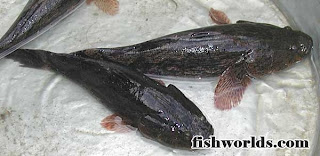Fish Betutu (Oxyeleotris marmorata)
Betutu (Oxyeleotris marmorata) is the name of a type of freshwater fish. Although somewhat rare large, fish spread in Southeast Asia to the archipelago favored anglers because betotan (pull) her strong and sudden.
Other names in various regions in Indonesia is Bakut, bakutut, belosoh (common name), boso, boboso, bodobodo, fish stupid, stupid cork, ketutuk, lazy fish, fish and other ghosts. In English is called marble or marble goby sleeper, referring to the color patterns on its body similar reddish marble.
Introduction
Small to medium-bodied fish with a large head. Body length (SL, standard length) to a maximum of about 65 cm, but most only between 20-40 cm or less. Faded brick red, brown or blackish, with dark patterns on his body symmetrical. Without spotting round (ocellus) at the base of its tail.
Dorsal fin (back) are next to face with six fingers hard (thorns), and the rear door with the spines and nine soft fingers. An anal fin with 7-8 spines and soft fingers. The scales in the middle of the back, from the back of the head to the base of the dorsal fin (supraneural scales) 60-65 pieces. The scales on the sides of the body, along the lateral line (lateral row scales) 80-90 pieces.
As reflected by its name, this fish lazy to move or migrate. He tends to say anything in the bottom waters, even harassed. Only at night betutu somewhat active, chasing shrimp, small fish, crab, or a water snail. Betutu fish found in the rivers at the sheltered, swamps, reservoirs, waterways or ditches.
Deployment
Betutu spread in Southeast Asia: Thailand, Vietnam, Cambodia, Laos, Malay Peninsula, the Philippines, and Indonesia: Sumatra, Kalimantan, Sulawesi and Maluku. Is also found in Java. Introduced to Singapore, Taiwan, China, and perhaps also Fiji.
Betutu favored fish as well as fish fishing fish consumption. Meat is tasty and tender.
scientific classification
Kingdom: Animalia
Phylum: Chordata
Class: Actinopterygii
Order: Perciformes
Family: Eleotridae
Genus: Oxyeleotris
Species: O. marmorata
Powered by Blogger.















0 comments :
Post a Comment